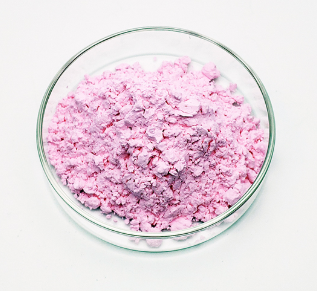|
| | Erbium(III) oxide Basic information |
| | Erbium(III) oxide Chemical Properties |
| Melting point | 2400°C | | Boiling point | 3000℃ | | density | 8.64 g/mL at 25 °C(lit.) | | vapor pressure | 0Pa at 25℃ | | storage temp. | Inert atmosphere,Room Temperature | | solubility | Soluble in acids | | form | Powder | | color | rose | | Specific Gravity | 8.64 | | Water Solubility | insoluble | | Sensitive | Hygroscopic | | Merck | 14,3646 | | InChIKey | VQCBHWLJZDBHOS-UHFFFAOYSA-N | | CAS DataBase Reference | 12061-16-4(CAS DataBase Reference) | | EPA Substance Registry System | Erbium oxide (Er2O3) (12061-16-4) |
| Hazard Codes | Xi | | Risk Statements | 36/37/38 | | Safety Statements | 36/37-24/25-36-26 | | WGK Germany | 2 | | RTECS | KD9250000 | | TSCA | Yes | | HS Code | 28469019 | | Toxicity | rat,LD50,oral,> 5gm/kg (5000mg/kg),Acute Toxicity Data. Journal of the American College of Toxicology, Part B. Vol. 12, Pg. 619, 1993. |
| | Erbium(III) oxide Usage And Synthesis |
| Description | Erbium(III) oxide (Er2O3) is a member of rare-earth sesquioxides. Er2O3 powder has a pink appearance and the crystal structure of the material is generally known to be cubic. Erbium oxide found to be insoluble in water and soluble in mineral acids. Er2O3 provides various excellent properties such as high dielectric constant (≈14), high mechanical strength, high chemical and thermal stability in contact with Si, wide bandgap (~5.4 eV), substantial hardness and high transparency in visible light. | | Chemical Properties | Pink powder that readily absorbs moisture and carbon dioxide from the atmosphere. infusible. Insoluble in water; slightly soluble in mineral acids.
Erbium(III) oxide (Er2O3), a pink solid, is a compound of erbium sometimes used as a colouring for glasses and a dopant for optical fibres and optical amplifiers. It was partially isolated by Carl Gustaf Mosander in 1843, and first obtained in pure form in 1905 by Georges Urbain and Charles James.

| | Uses | Erbium (III) oxide also called Erbia, an important colourant in glasses and porcelain enamel glazes. High purity Erbium Oxide are widely applied as dopant in making optical fibre and amplifier. It is particularly useful as an amplifier for fiber optic data transfer. Erbium Oxide has a pink color, and is sometimes used as a colorant for glass, cubic zirconia and porcelain. The glass is then often used in sunglasses and cheap jewelry.
Erbium (III) oxide is easy to produce other Erbium compounds with this material. It has been used to impart a pink shade to glass and porcelain.
| | Uses | Erbium(III) oxide is used for vacuum deposition electrical, optical and photoluminescenc, gate dielectrics in semi conductor devices, and in Biomedicine. | | Application | Erbium(III) oxide are utilized in different applications such as protective materials and in corrosion-resistant coatings, electrically insulating coating material, sensing membranes for pH detection, alternative gate oxides to replace silicon oxide in metal oxide semiconductor devices, display monitors, optical communication, Hall effect sensors, imaging in biological systems, and probing solution complexation properties. Furthermore, Er2O3 exhibits a good catalytic performance during the oxidative dehydrogenation of ethane to ethylene. | | Flammability and Explosibility | Nonflammable |
| | Erbium(III) oxide Preparation Products And Raw materials |
|



